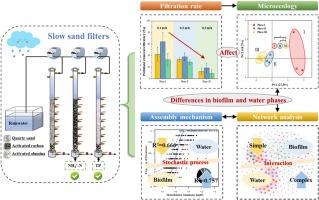具有可变过滤速率的慢砂过滤器用于雨水净化:生物膜和水相之间的微生态差异。
IF 8.4
2区 环境科学与生态学
Q1 ENVIRONMENTAL SCIENCES
引用次数: 0
摘要
近年来,慢沙过滤器在雨水净化中的应用越来越广泛,但对慢沙过滤器对降雨波动的响应以及慢沙过滤器中生物膜和水相微生态的研究尚不清楚。本研究系统评价了SSFs的雨水净化性能,比较了生物膜与水相之间的细菌群落结构、组装过程和分子生态相互作用。活性炭过滤器和活性氧化铝过滤器对NH4+-N(18.82% ~ 64.00%)和TP(>90%)的去除率最高。当过滤速率从0.1 m/h增加到0.3 m/h时,3种SSFs的雨水净化效率显著下降,Tolumonas、Desulfovibrio和Sulfurospirillum富集,Klebsiella和Enterobacter减少。生物膜阶段的群落多样性显著高于水阶段,过滤速率是影响两阶段细菌群落形成的关键因素。过滤速率与水质的交互作用表现出最佳的显著性(p本文章由计算机程序翻译,如有差异,请以英文原文为准。

Slow sand filters with variable filtration rates for rainwater purification: Microecological differences between biofilm and water phases
Slow sand filters (SSFs) have been increasingly applied to rainwater purification in recent years, but the response of SSFs to fluctuating rainfall, as well as the biofilm- and water-phase microecology in SSFs are still poorly understood. This study systematically evaluated the rainwater purification performance of SSFs and compared the bacterial community structure, assembly processes and molecular ecological interactions between the biofilm and water phases. The activated carbon and activated alumina filters exhibited the best performance for NH4+-N (18.82%∼64.00%) and TP (>90%) removal, respectively. As the filtration rate increased from 0.1 m/h to 0.3 m/h, the rainwater purification efficiencies of the three SSFs deteriorated significantly, with the enrichment of Tolumonas, Desulfovibrio and Sulfurospirillum, and reduction in Klebsiella and Enterobacter. The community diversity of biofilm phase was significantly higher than that of water phase, and filtration rate was identified as a key factor in shaping the bacterial community in both phases. The interactions of filtration rate and water quality displayed the best and significant (p < 0.01) explanation for microbiome shift, with the higher values in biofilm phase (34.70%) than in water phase (24.02%). Bacterial community assembly in SSFs was determined by stochastic ecological processes, which played a more important role in water-phase communities, with 86.34% following predictions using a neutral community model. The molecular ecological network of biofilm phase exhibited more complexity, lower modularity and more cooperative relationships than that of water phase. Disadvantaged OTUs occupied core and notable positions in the network, with the highest degree and clustering coefficient. Different keystone species were identified in biofilm- (Runella, Aquabacterium, etc) and water-network (Terrimonas) respectively, despite they processed low relative abundances (<0.1%). These results enhance the understanding of microecology in SSFs, and shed new lights on the improvement and promotion of rainwater biological treatment technology.
求助全文
通过发布文献求助,成功后即可免费获取论文全文。
去求助
来源期刊

Journal of Environmental Management
环境科学-环境科学
CiteScore
13.70
自引率
5.70%
发文量
2477
审稿时长
84 days
期刊介绍:
The Journal of Environmental Management is a journal for the publication of peer reviewed, original research for all aspects of management and the managed use of the environment, both natural and man-made.Critical review articles are also welcome; submission of these is strongly encouraged.
 求助内容:
求助内容: 应助结果提醒方式:
应助结果提醒方式:


